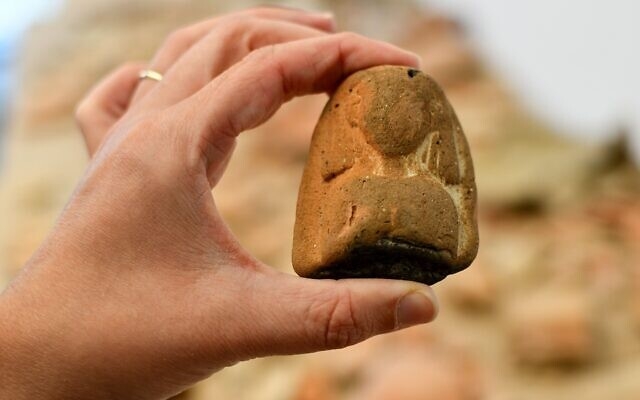A more than 3,000-year-old small statue, identified with the Egyptian goddess Hathor, was discovered by a hiker in the Palmahim Beach National Park in Israel and was handed over to the State Treasures.
Lydia Marner, 74 years old from Lod, immigrated to Israel from Azerbaijan with her husband and two daughters. Since her retirement from her job as a mediator in the Ministry of Welfare, she and her husband have been going on weekly trips to Palmachim beach. "The beach is one of our favorite places in Israel," she said. "Almost every week we go on family trips, sometimes we even go to the sea, and this is a place of very high family value for us."
Priestess of Hathor from Asyut
— Egypt Museum (@egyptmuse) June 12, 2023
New Kingdom, 18th Dynasty, c. 1395-1186 B.C.
Cincinnati Art Museum. 1966.266 pic.twitter.com/kQcqCrVpa2
About a month ago, during one of the weekly trips, while walking along the beach, she noticed something sticking out of the sea. "It was a rather stormy day; the waves were high, and the weather was wintry. During the walk by the water, I noticed that some kind of stone was coming towards me. I immediately called my husband and told him, 'It's not just a coincidence,' I saw that there was something beyond here."
Palmachim beachgoer finds 3,000-year-old Egyptian goddess figurine https://t.co/aPcS5fRVLP
— The Times of Israel (@TimesofIsrael) June 13, 2023
Lydia took a picture of the find and tried to check with her acquaintances who understand the subject what it is. They immediately told her it looked like something that needed to be looked into by the professionals. She turned to the Antiquities Authority's Facebook page, and Dror Citron and Idan Horn, inspectors from the Authority, came to examine the special find. After an examination, it turned out that the find was none other than a figurine, identified with the Egyptian goddess Hathor.
• This Egyptian Goddess Hathor figurine stands at 11.5" tall, 6.5" long and 4.5" deep approximately. • This Egyptian Goddess Hathor figurine is made of designer composite resin, hand painted and polished individually. Color Tone May Vary • Hathor is an... pic.twitter.com/bw1HSPrmNg
— 𝕻𝖆𝖌𝖆𝖓𝖆𝖗𝖙𝖎𝖘𝖆𝖓 (@paganartisan) December 9, 2022
According to Dr. Amir Golani, an expert on the Bronze Age at the Antiquities Authority, "These figurines, which were used for worship and are usually identified with the Egyptian goddess Hathor, are typical of the Canaanite culture in the Land of Israel - mainly in the Late Bronze Age and also in the Iron Age. The Canaanites used to adopt the ritual and religious customs of the Egyptians, who ruled over the region at that time. Just like in homes today, where you install a mezuzah or hang a picture of a saint on the wall, back then they used to place ritual figurines in a central place in the house, for good luck and protection from bad things. Although the statuette is very worn, its size is well known to us.”


